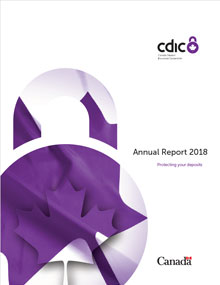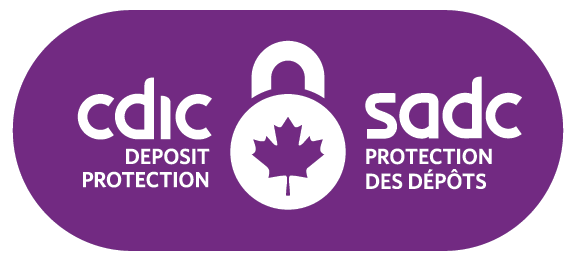
In its 2018/2019 to 2022/2023 Corporate Plan (PDF 3.6 MB), CDIC committed to seek the views of member institutions through a member survey measuring the effectiveness of CDIC’s interactions with its member institutions. This initiative is in support of CDIC’s objective to foster a collaborative and productive relationship with member institutions.
In January 2019, Peter Routledge, CDIC President and CEO, formally invited 54 CDIC member groups to provide feedback (on a de-identified basis) on a number of CDIC’s processes, and their overall impressions of the Corporation. CDIC commissioned public opinion research firm Nielsen to assist with the survey process, including programming, receiving and analyzing responses. The survey was open to members from January 17 to February 6, 2019. Feedback was sought on several specific processes
- Differential premiums system and processes
- Deposit Insurance Information By-law consultations and tools
- Data and System Requirements tools and processes
- Joint and Trust Disclosure By-law consultations
- Resolution planning processes and guidance, and the bail-in consultation process
In total, 23 complete responses were received: five from DSIBs and 18 from non-DSIBs. Feedback was generally positive, and members suggested specific areas where there is room for improvement. Highlights include:
- All respondents say they have a good understanding of CDIC’s role in the safety net, and nearly all said they are satisfied with the clarity of CDIC’s information and processes, and the helpfulness of CDIC staff.
- Results show that members have a clear preference for learning about CDIC matters and changes to CDIC requirements by means of direct correspondence and interaction between CDIC staff and the members’ executive or regulatory compliance staff, in combination with updates to the CDIC website.
- Respondents identified several areas for improvement including better transparency of CDIC processes; as well as increased usefulness of guidance on resolution planning, premiums, the Information By-law, data and system requirements, and brokered deposits. Members also suggested that CDIC ensure that consultations with members are sufficiently inclusive (including regular touchpoints), and that CDIC provide ample time for members to both comment on proposed changes, and to implement changes.
Members provided balanced, helpful and actionable feedback and suggestions, in particular concerning CDIC’s general approach to consultations, premium process enhancements, and resolution planning guidance. CDIC is planning actions to respond to the survey findings and will share plans and action items directly with members.

As at December 31, 2018, CDIC’s most recent published financial results (PDF 1.4 MB), the Corporation’s ex ante funding stood at $4.9 billion, or 59 basis points of insured deposits compared to its minimum target level of 100 basis points of insured deposits. Currently, CDIC expects to meet its minimum target by March 31, 2026.
Premium revenue was $162 million for the third quarter and is expected to total $645 million for the entire fiscal year. Net operating expenses were $11 million in Q3 and are forecasted at $43 million for the year, $5 million under the budget originally set.
As at April 30, 2018, the last reporting date for our members, total member deposits stood at $3.08 trillion and insured deposits were $792 billion, up 2.3% from last year.
T+0: CDIC’s Audacious Goal
The Board of Directors of the Canada Deposit Insurance Corporation (CDIC) is pleased to announce that its 2019 Annual Public Meeting will be held in conjunction with The Summit, Payments Canada’s annual industry conference, in Toronto on May 15, 2019. The meeting will feature a panel discussion on the modernization of deposit reimbursement.
Peter Routledge, President and CEO of CDIC, will be joined by a panel of CDIC subject matter experts for a conversation titled “T+0: CDIC’s audacious goal”. They will be speaking about the steps CDIC is taking toward its goal of ensuring Canadians have immediate access to their protected savings in the event of a member institution failure.
In particular, CDIC will discuss its plans to modernize its reimbursement program and systems with an aspiration of being able to reimburse depositors on the day of failure (T+0). These also include working closely with member institutions and financial professionals to facilitate the quick and accurate payment to depositors. These efforts will ensure CDIC keeps pace with a changing banking landscape and Canadians can continue to save and bank with confidence.
Members of the public are invited to participate and will also have the opportunity to ask questions of the panel in advance by emailing smenquiries@cdic.ca or in real time by tweeting @CDIC_CA in English or @SADC_CA in French.
Event Details:
The event will take place at the Beanfield Centre, 105 Princes’ Blvd, Toronto, on May 15, 2019 at 2:15 pm, Eastern Time. To attend in person please email CDIC at smenquiries@cdic.ca.
Like us on Facebook for regular updates. You can also follow us on Twitter and tweet us your questions during the event @CDIC_CA in English and @SADC_CA in French.
View CDIC’s 2018 Annual Report.
The Government of Canada has announced that changes to CDIC deposit protection originally slated for April 30, 2021 are deferred by one year and will now come into force on April 30, 2022. Content on this page was posted prior to this announcement. References to April 30, 2021 should be read as April 30, 2022.
OTTAWA – April 3, 2019 – Parliament approved changes to the Canada Deposit Insurance Corporation Act that will strengthen and modernize deposit protection.
CDIC today welcomes the announcement of the dates these amendments will take effect. The changes will occur in two phases, including:
Phase 1 (effective April 30, 2020)
- Expanded coverage to include eligible deposits held in foreign currency
- Extended coverage to eligible deposits with terms greater than 5 years
- Elimination of coverage for travellers cheques (CDIC member institutions no longer issue travellers cheques)
Phase 2 (effective April 30, 2021)
- Separate coverage for up to $100,000 in eligible deposits in Registered Education Savings Plans (RESPs) and Registered Disability Savings Plans (RDSPs)
- Mortgage tax accounts will no longer receive a separate $100,000 in coverage but will continue to be covered under other insurance categories.
- New requirements for deposits held in trust, including deposits held by nominee brokers for their clients, that enhance CDIC’s ability to extend protection to these deposits and reimburse them quickly after a CDIC member failure.
The phased implementation will allow CDIC, its member institutions and other stakeholders to make the necessary procedural or operational adjustments to accommodate the changes.
“CDIC has protected Canadians’ hard-earned savings for over 50 years,” said Peter Routledge, CDIC President and CEO. “These changes will strengthen and modernize our deposit insurance framework to ensure we keep pace with the way Canadians save their money.”
CDIC is a federal Crown corporation established in 1967 to protect the savings of Canadians, and we contribute to financial stability by safeguarding over $792 billion in deposits at more than 80 member institutions. As resolution authority, we are responsible for handling the failure of any of our members, from the smallest to the largest. Our members include banks, federally regulated credit unions as well as loan and trust companies and associations governed by the Cooperative Credit Associations Act that take deposits. We are funded by premiums paid by member institutions and do not receive public funds to operate. We have resolved 43 member failures affecting some two million Canadians. No one has lost a dollar of deposits under CDIC protection.
– 30 –
Additional information:
Brad Evenson
Director, Communications and Public Affairs
Tel: 613.943.4395
E-mail: media@cdic.ca
Building Financial Resilience: CDIC’s Role in Promoting Confidence in Canada’s Financial System
March 26, 2019
Speaking Notes by Peter Routledge, President and CEO, CD Howe Institute – March 26, 2019

With the coming into force of the bail-in regulations on September 23, 2018, Canada’s bail-in regime is now in place. This is a major milestone for Canada’s resolution regime and provides CDIC with a powerful tool to resolve a domestic systemically important bank (D-SIB) in the unlikely event that it fails or is about to fail.
Bail-in designed to reduce risk
In a bail-in, CDIC would take control of a failing D-SIB and recapitalize it by converting bail-in debt into equity, while ensuring that the bank remains open and continues to provide critical services to its customers. This is designed to preserve financial stability, minimize disruptions to the financial system, reduce taxpayer exposure and reduce incentives for systemically important banks and their shareholders to take excessive risk.
For further information on the bail-in tool and how it could be used, consult our backgrounder.
The 2008 financial crisis: impetus for change
The 2008 global financial crisis brought to light that some banks are “systemically important.” In other words, they are so important to the functioning of the financial system and economy that they cannot be wound down under a conventional bankruptcy and liquidation process without resulting in unacceptable costs to the economy. These institutions are commonly labelled as “too-big-to-fail.” With inadequate tools to deal with failed systemically important banks, authorities in other jurisdictions were forced to rely on taxpayer-funded capital injections (“bail-outs”) to support these institutions, in the interests of broader financial and economic stability. In contrast, a “bail-in” is intended to ensure that a failing bank’s creditors and shareholders—not taxpayers—bear the burden of the failure, by having their debt converted into common shares.
Regulations to implement the bail-in regime
While legislation established the bail-in framework, it left much of the details of the regime to regulation. There are two bail-in regulations:
- The Bank Recapitalization (Bail-in) Conversion Regulations. These regulations (under the CDIC Act) set out which instruments are subject to the bail-in power and factors that CDIC must consider in exercising the bail-in power. They apply to Canada’s D-SIBs.
- The Bank Recapitalization (Bail-in) Issuance Regulations. These regulations (under the Bank Act) set out requirements that D-SIBs would have to follow when issuing bail-in debt. They apply to Canada’s D-SIBs.
These two bail-in regulations, which came into force on September 23, 2018, along with the Office of the Superintendent of Financial Institution’s (OSFI) Total Loss Absorbing Capacity (TLAC) Guideline, ensure that D-SIBs have sufficient loss-absorbing capacity to support their recapitalization in the unlikely event of a failure. Under OSFI’s TLAC Guideline, D-SIBs are required to hold a minimum capacity to absorb losses, which acts as a buffer to protect depositors and taxpayers from loss. D-SIBs have until November 2021 to build these buffers, which can be composed of regulatory capital instruments and bail-in eligible senior debt.
Bail-in issuances
With the coming into force of the bail-in regulations, D-SIBs are now able to issue bail-in eligible instruments, and one D-SIB has already done so. On September 24, 2018, the Royal Bank of Canada (RBC) launched the inaugural issuance of bail-in eligible senior notes in Canada. RBC issued $2 billion in senior notes with a 5-year maturity attracting a broad investor base. The notes were issued at a spread of around 10 to 12 basis points over outstanding non-bail-inable senior notes. It is expected that other D-SIBs will also begin issuing bail-in eligible instruments in the short term in a number of markets.
Planning for bail-in resolution
In order to ensure CDIC is prepared for any banking failures, CDIC requires D-SIBs to develop resolution plans. These plans describe how D-SIBs could be resolved in an orderly manner, while ensuring the continuity of critical financial services. As part of this work, D-SIBS will be expected to demonstrate that they are prepared to support a bail-in conversion, including having the necessary data, systems and capabilities in place. CDIC is working with the D-SIBs to ensure these plans are realistic, credible and implementable so that Canadians can have confidence in the stability of the financial system.
Compensation Regime
In addition to the bail-in regulations, new compensation regulations came into force in March 2018. The Compensation Regulations (under the CDIC Act) set out an updated process for providing compensation to shareholders and creditors of CDIC federal member institutions if they are made worse off as a result of CDIC’s actions to resolve the institution (including through bail-in) than they would have been if the institution were liquidated. The regulations apply to all CDIC member institutions, and to all resolution tools (except payout and liquidation).

Canada Deposit Insurance Corporation’s 2018 Annual Report was tabled in Parliament in October 2018. Among CDIC’s achievements and activities for fiscal year 2017/18, there is a clear theme: protecting depositors in an evolving environment.
Here are some highlights of achievements and activities over the past year:

- CDIC, with its safety net partners, finalized regulations for a bank recapitalization (bail-in) regime. The regulations represent a major milestone toward ending “too big to fail” by ensuring that taxpayers do not have to bail out large banks in distress.
- CDIC launched a new public awareness strategy to ensure that Canadians are aware of deposit protection. In parallel with the new campaign, CDIC modernized requirements for its member institutions in promoting awareness of deposit protection through an updated Deposit Insurance Information By-law.
- In collaboration with the federal government, CDIC enhanced Canada’s deposit protection framework to ensure CDIC coverage reflects an evolving financial landscape and the changing needs of consumers.
- The Corporation continued to play a leadership role in the international arena, building strong relationships with international counterparts to increase cross-border cooperation and to share best practices in resolution with our international peers.
Whether it is through a modernized deposit insurance framework or the strengthening of our role as Canada’s resolution authority, CDIC continues to innovate and expand its capabilities to protect depositors in an increasingly complex and ever-evolving financial landscape.

March 28, 2018 – For 50 years CDIC has protected the hard-earned savings of Canadians. We do this by insuring the eligible deposits of Canadians in some 80 member institutions. Member institutions range from small trust companies and banks, to federal credit unions, to Canada’s largest and most complex banks (Domestic Systemically Important Banks referred to as D-SIBs). CDIC benefits from a wide array of powers to address a failing member institution—from liquidation and reimbursement of insured depositors, to tools to address a failing D-SIB.
At the operational level, we have internal plans to address these possible failure scenarios, as well as the people and resources required to implement the plans. We also test ourselves regularly to fine-tune our preparedness. We are proud to say that over the course of our history we have resolved 43 member institutions and no depositor lost one dollar of their insured savings.
Serving as resolution authority for Canada’s largest banks
Following the seismic impact of the 2008 global financial crisis, it became clear to countries around the world that gaps existed in the resolution of large (systemic) banks. Today this focus forms a key part of the sweeping financial reform agenda now well underway around the world.
In 2011 CDIC became Canada’s resolution authority responsible for resolving our D-SIBs which has led to changes at CDIC but also in the legislative framework that supports a resolution of these banks.
Powers and tools at our disposal for D-SIBs
One of the key tools we now have is the power of “bail-in.” In a bail-in, CDIC would take control of the bank and recapitalize it by converting bail-in debt into equity, while ensuring that the bank remains open and continues to provide critical services to its customers. This would minimize disruptions to the financial system, reduce taxpayer exposure, and reduce incentives for systemically important banks and their shareholders to take excessive risk. Work on the regulations to support the bail-in regime should be completed this year.
At the same time, we have worked with our D-SIBs on their resolution plans over the past several years—plans ready to be operationalized if the D-SIB were to fail. We received the first bank-authored plans in late 2016. We assessed the plans and have worked with the banks to identify actions needed to ensure we have high quality plans by 2020 so that the banks could be resolved in an orderly manner.
CDIC’s new powers and responsibilities, combined with those of our safety-net partners, align with the criteria set out by the Financial Stability Board’s Key Attributes of Effective Resolution Regimes (PDF, 436 KB).
As technology and banking methods continue to evolve, we will continue to adjust the approaches we take to ensure that resolution plans remain actionable in the unlikely event that one of Canada’s largest banks faces severe threats to its viability. This strengthens Canada’s financial system and its position among G20 nations.

March 28, 2018 – CDIC celebrated 50 years in 2017. To mark this milestone, CDIC asked C. Ian Kyer, author, historian and lawyer to look back at the people and events that have shaped CDIC since 1967. The story actually begins before confederation, more than 100 years before CDIC was established.
From Next Best to World Class: The People and Events that Have Shaped the Canada Deposit Insurance Corporation, 1967–2017 (PDF), captures the rich history and political and economic context of how and why CDIC came to be and the events and circumstances that contributed to building CDIC from the ground up.
We invite readers to dive into this historical treasure.

Not a dollar of depositors’ insured money lost under CDIC’s watch
Since 1967, CDIC has resolved 43 member failures which together affected about two million depositors. Not one depositor lost a single dollar of insured savings. Moreover, these insured deposits were repaid by our members through the premiums they pay to CDIC’s deposit fund.
CDIC covers eligible deposits at each of our member institutions, to a maximum of $100 000 per depositor, per insured category. Some products are not covered by CDIC. To see a full list of what’s covered (and not covered) by CDIC and to calculate your CDIC coverage, try our deposit insurance estimator.
CDIC: An excellent source of information on protecting your savings
Canadians have many different financial needs, questions and concerns at each stage of their lives. No matter what your financial goals, CDIC is here to help you make informed decisions about the safety of your savings.
OTTAWA – February 11th, 2019 – The Canada Deposit Insurance Corporation (CDIC) welcomes Motus Bank to its membership. Headquartered in Ontario, Motus Bank is a wholly owned subsidiary of Meridian Credit Union.
For more than 50 years, CDIC has protected Canadians’ deposits and promoted financial stability. Eligible deposits at Motus Bank will now be protected up to $100,000 per deposit category.
CDIC is a federal Crown corporation established in 1967 to protect the savings of Canadians, and we contribute to financial stability by safeguarding over $792 billion in deposits in all our member institutions. As resolution authority, we are responsible for handling the failure of any of our members, from the smallest to the largest.
CDIC is funded by premiums paid by member institutions and does not receive public funds to operate. We have dealt with 43 member failures affecting some two million Canadians. No one has lost a dollar of deposits under CDIC protection.
Look for this logo to identify a CDIC member institution:

For more information about CDIC please go to www.cdic.ca.
For more information about CDIC’s newest member, please visit www.motusbank.ca.
Further information:
Brad Evenson
Director, Communications and Public Affairs
Tel: 613.943.4395
E-mail: media@cdic.ca
CDIC appoints Executive Vice-President, Insurance and Risk and Chief Risk Officer
December 6, 2018
OTTAWA – December 6, 2018 – The Canada Deposit Insurance Corporation (CDIC) is pleased to appoint Dean Cosman as Executive Vice-President, Insurance and Risk and Chief Risk Officer.
This new position broadens Mr. Cosman’s current responsibilities of risk assessment and insurance to reflect the Corporation’s intensified focus on enterprise risk management. The new role will also leverage Mr. Cosman’s international experience to deepen CDIC’s global leadership in deposit insurance and resolution through membership in the International Association of Deposit Insurers (IADI).
“Dean is a respected leader with a keen understanding of the financial sector, and we are delighted he has agreed to take on these important new responsibilities,” said CDIC President and CEO, Peter Routledge.
Mr. Cosman, who first joined CDIC in 1995, has more than 20 years of experience with Crown corporations, most recently as CDIC’s Senior Vice President, Insurance and Risk Assessment. He was recently appointed to IADI’s Executive Council and as Chair of IADI’s Regional Committee of North America.
CDIC is a federal Crown corporation established in 1967 to protect the savings of Canadians, and we contribute to financial stability by safeguarding over $792 billion in deposits at more than 80 member institutions. As resolution authority, we are responsible for handling the failure of any of our members, from the smallest to the largest. Our members include banks, federally regulated credit unions as well as loan and trust companies and associations governed by the Cooperative Credit Associations Act that take deposits. We are funded by premiums paid by member institutions and do not receive public funds to operate. We have dealt with 43 member failures affecting some two million Canadians. No one has lost a dollar of deposits under CDIC protection.
– 30 –
Further information:
Brad Evenson
Director, Communications and Public Affairs
Tel: 613.943.4395
E-mail: media@cdic.ca
